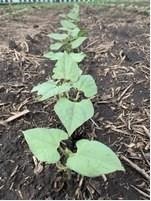North Dakota State University Extension has had a long-term recommendation of establishing pinto bean at 70,000 plants per acre, and black and navy bean at 90,000 plants per acre in wide (30-inch) rows.

Pinto bean row spacing evaluated as a single factor across multiple trials indicated a yield increase of 20% with 15- to 22-inch rows versus wide rows. (NDSU photo)
However, based on an annual dry bean grower survey, farmers growing black and navy bean are using greater plant populations and narrower rows, says Greg Endres, NDSU Extension cropping systems specialist. A lesser trend exists for pinto bean farmers.
“With support from Northarvest Bean Growers Association, NDSU has been conducting field trials during the past decade to examine the potential for yield increase with the three dry bean market types as impacted by these two plant-establishment factors,” says Endres.
Research trials with black and navy bean were conducted in eastern North Dakota, near Carrington, Park River and Prosper from 2014 to 2018 that included targeted, early-season populations of 90,000, 110,000 and 130,000 plants per acre with row spacings of 14, 18 or 21, and 28 inches.
Black bean seed yield was 13% to 14% greater with narrow (14-inch) row spacing compared to wide (28-inch) rows. Average plant population ranging from about 100,000 to 150,000 plants per acre provided similar yield. Narrow rows with navy bean plant populations of greater than 115,000 plants per acre increased yield 24% to 28% compared to wide rows, with slightly more than 90,000 plants per acre.
From 2018 to 2021, the Carrington and Langdon Research Extension Centers, conducted a pinto bean field study comparing intermediate (18- or 21-inch) to wide (28- or 30-inch) row spacing and targeted stands of 50,000, 70,000 and 90,000 plants per acre. Seed yield was primarily impacted by row spacing. Average yield increase was 17% with intermediate row spacing and plant populations of about 65,000 or 84,000 plants per acre versus wide rows.
Pinto bean row spacing evaluated as a single factor across 11 trials (Carrington, Langdon and Minot; 2011 to 2013 and 2018 to 2021) indicates a yield increase of 20% with 15- to 22-inch rows versus wide rows. Plant population evaluated as a single factor across four trials (Carrington and Langdon; 2018 to 2021) indicates a yield increase of 5% with population at 87,000 plants per acre compared to a population similar to the standard density of 70,000 plants per acre.
Source : ndsu.edu